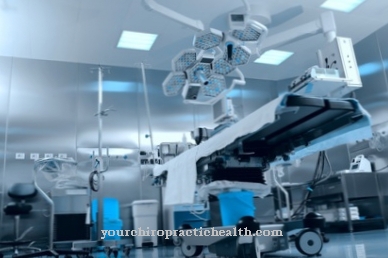A Curing light is a lamp that belongs to the basic equipment of dental practices. It is needed to harden fillings.
What is a curing light?

Polymerization lamps are special lamps that have a blue light. In this light, composite fillings, also known as plastic fillings in colloquial language, can harden.
The light generated by the polymerization lamps is cold light. Cold light is a light with a particularly reduced infrared component.
Shapes, types & types
When it comes to curing lights, a distinction is made between halogen and LED lamps. Devices with a built-in halogen lamp generate a lot of heat. Since cold light is required for the polymerization, as otherwise the tooth pulp can be damaged, these devices must be cooled with a built-in fan.
A disadvantage of halogen lamps is their diminishing performance. With normal use, the luminosity decreases significantly within two to six years. Because of these disadvantages, LED lamps are increasingly found in dental practices.
For the first time, LEDs were used as light sources in curing lights in 1995. The advantage of LED lamps is that they generate little heat. The lamps generate significantly less heat and therefore also use less electricity. That is why it can even be used in cordless tools. Halogen lamps must always be connected to the mains.
It is important that the light output is evenly and effectively distributed over the entire light beam. One speaks here of a balanced radiation profile. A polymerization lamp can be assessed on the basis of its light output. This provides information about the average radiation intensity, measured via the so-called emitted wavelength spectrum of the light exit window.
In addition to mains-operated and battery-operated lamps, a distinction can also be made between conventional and soft-start polymerization lamps. While the full light output is available with conventional lamps immediately after switching on, the soft start lamps only emit a reduced light output in the first ten to twenty seconds after switching on. This is actually intended to reduce possible stresses in the filling. Studies have shown, however, that soft polymerization has neither advantages nor disadvantages.
Structure & functionality
Light-curing plastics are used nowadays for plastic fillings and veneers. These are usually so-called composites. Composites are filling materials that consist of an organic plastic matrix on the one hand and an inorganic filler body on the other.
The polymerization, i.e. in the broadest sense the hardening of the material, takes place in three steps. Put simply, free radicals of certain molecules in the composite look for another free radical during polymerization. This creates stable connections and the material hardens. So-called initiators are added to the plastic material so that this chemical reaction gets going. It is through this that the radicals are formed. The light from the polymerization lamp is a prerequisite for the formation of radicals from the initiators. This causes a start reaction (initiation). Within a short period of time, more and more radicals and thus more and more connections (growth reaction / propagation) are formed. The more molecules that are formed, the more stable the connection and thus also the plastic filling. When all the molecules present have bonded, the polymerization ends.
An energy dose of 12 to 16 J / cm² is required for polymerisation with the polymerisation lamp. The deeper the filling, the less light still hits the filling material. Very deep fillings must therefore be hardened in several layers.
You can find your medication here
➔ Medicines against tartar and tooth discolorationMedical & health benefits
In the past, three materials were generally used in dentistry to fill tooth holes: amalgam, gold or silver. These materials harden on their own. But gradually the disadvantages of these filling materials became noticeable. Dental amalgam consists to a not inconsiderable amount of mercury. Due to mechanical loads, the amalgam can loosen from the teeth in pieces over time. The consequence can be mercury exposure of the body. This manifests itself in various complaints.
Gold and silver have the disadvantage that they cannot be shaped directly on the tooth. A plaster model of the tooth must first be created. A gold inlay can be formed from this plaster mold. Further disadvantages of fillings made of gold are the striking color and the electrochemical reactions that take place when it comes into contact with other metal fillings such as silver fillings.
In order to meet health and aesthetic requirements, more and more plastic fillings were used. Plastic fillings can be designed in the respective tooth colors and are therefore inconspicuous. They are mercury-free and also stabilize the tooth substance due to the bond adhering to the dentin. Also, undercuts that require tooth substance, such as with amalgam fillings, are not necessary with plastic fillings.
In the 1970s, UV lamps were primarily used to cure these fillings. However, these lamps harbored various health risks. On the one hand, there was a risk of blindness during the treatment due to the proximity to the eyes and, on the other hand, the lamps increased the risk of skin cancer on the face. Therefore, in the early 80s, the dangerous UV lamps were replaced by blue light lamps, the forerunners of today's polymerization lamps. Thanks to the polymerization lamps available today, the insertion and curing of plastic fillings is now possible quickly and safely.

























.jpg)


